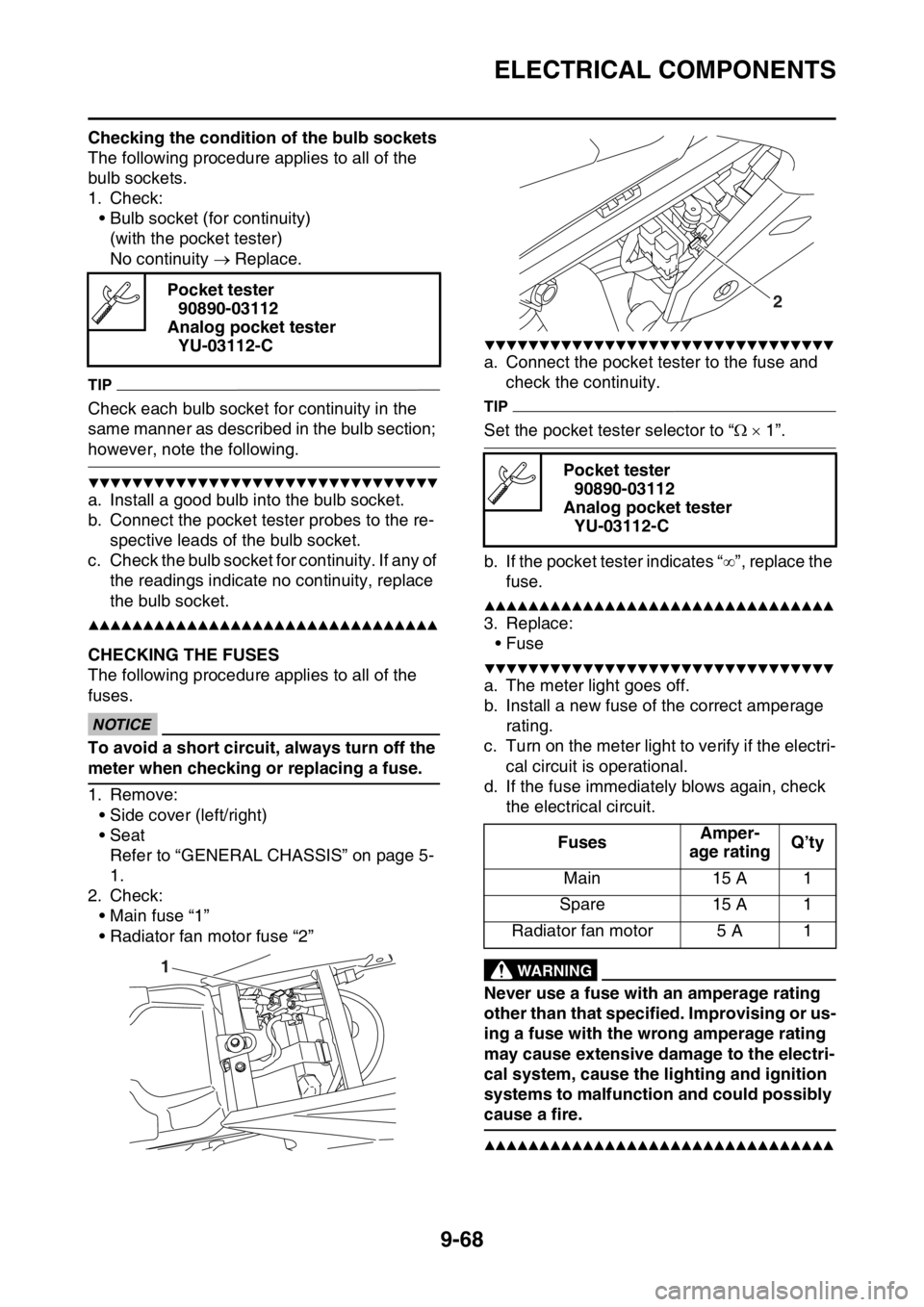fuses YAMAHA WR 450F 2016 Owners Manual
[x] Cancel search | Manufacturer: YAMAHA, Model Year: 2016, Model line: WR 450F, Model: YAMAHA WR 450F 2016Pages: 426, PDF Size: 10.86 MB
Page 62 of 426

ELECTRICAL SPECIFICATIONS
2-11
Starter motorPower output 0.48 kW
Armature coil resistance 0.0117–0.0143
Brush overall length 7.0 mm (0.28 in)
Limit 3.50 mm (0.14 in)
Brush spring force 3.92–5.88 N (400–600 gf, 14.11–21.17 oz)
Commutator diameter 17.6 mm (0.69 in)
Limit 16.6 mm (0.65 in)
Mica undercut (depth) 1.50 mm (0.06 in)
Starter relay Amperage 180.0 A
Coil resistance 4.18–4.62
Starting circuit cut-off relay
Coil resistance 75.7–92.5
Headlight relay
Coil resistance 75.7–92.5
Fuses
Main fuse 15.0 A
Radiator fan motor fuse 5.0 A
Spare fuse 15.0 A
Page 330 of 426

ELECTRICAL COMPONENTS....................................................................... 9-60
CHECKING THE SWITCHES .................................................................. 9-64
CHECKING THE BULBS AND BULB SOCKETS .................................... 9-67
CHECKING THE FUSES ......................................................................... 9-68
CHECKING AND CHARGING THE BATTERY ........................................ 9-69
CHECKING THE RELAYS ....................................................................... 9-72
CHECKING THE DIODE .......................................................................... 9-73
CHECKING THE IGNITION SPARK GAP................................................ 9-73
CHECKING THE SPARK PLUG CAP ...................................................... 9-73
CHECKING THE IGNITION COIL ............................................................ 9-74
CHECKING THE CRANKSHAFT POSITION SENSOR........................... 9-74
CHECKING THE LEAN ANGLE SENSOR............................................... 9-75
CHECKING THE STARTER MOTOR OPERATION ................................ 9-75
CHECKING THE STATOR COIL ............................................................. 9-76
CHECKING THE RECTIFIER/REGULATOR ........................................... 9-76
CHECKING THE SPEED SENS OR ......................................................... 9-77
CHECKING THE FUEL SENDER ............................................................ 9-77
CHECKING THE RESISTER ................................................................... 9-77
CHECKING THE RADIATOR FAN MOTOR ............................................ 9-78
CHECKING THE COOLANT TEMPERATURE SENSOR........................ 9-78
CHECKING THE THROTTLE POSITION SENSOR ................................ 9-79
CHECKING THE THROTTLE POSITION SENSOR INPUT VOLTAGE .. 9-79
CHECKING THE INTAKE AIR PR ESSURE SENSOR ............................ 9-80
CHECKING THE INTAKE AIR TEMPERATURE SENSOR ..................... 9-80
CHECKING THE FUEL INJECTOR ......................................................... 9-81
Page 334 of 426

IGNITION SYSTEM
9-4
EAS2GC1360TROUBLESHOOTING
The ignition system fails to operate (no spark or intermittent spark).
TIP
Before troubleshooting, remove the following part (s):
1. Seat
2. Side cover (left/right)
3. Air scoop (left/right)
4. Fuel tank
5. Air filter case cover1. Check the fuse. Refer to “CHECKING THE FUSES”
on page 9-68. NG
Replace the fuse(s).
OK
2. Check the battery. Refer to “CHECKING AND
CHARGING THE BATTERY” on
page 9-69. NG
• Clean the battery terminals.
• Recharge or replace the battery.
OK
3. Check the spark plug. Refer to “CHECKING THE SPARK
PLUG” on page 3-40. NG
Re-gap or replace the spark plug.
OK
4. Check the ignition spark gap. Refer to “CHECKING THE IGNI-
TION SPARK GAP” on page 9-73. OK
The ignition system is normal.
NG
5. Check the ignition coil. Refer to “CHECKING THE IGNI-
TION COIL” on page 9-74. NG
Replace the ignition coil.
OK
6. Check the crankshaft position sen- sor.
Refer to “CHECKING THE CRANK-
SHAFT POSITION SENSOR” on
page 9-74. NG
Replace the stator assembly.
OK
7. Check the engine stop switch. Refer to “CHECKING THE
SWITCHES” on page 9-64. NG
Replace the engine stop switch.
OK
Page 340 of 426

ELECTRIC STARTING SYSTEM
9-10
EAS2GC1363TROUBLESHOOTING
The starter motor fails to turn.
TIP
Before troubleshooting, remove the following part (s):
1. Seat
2. Side cover (left/right)
3. Air scoop (left/right)
4. Fuel tank
5. Air filter case cover1. Check the fuse. Refer to “CHECKING THE FUSES”
on page 9-68. NG
Replace the fuse(s).
OK
2. Check the battery. Refer to “CHECKING AND
CHARGING THE BATTERY” on
page 9-69. NG
• Clean the battery terminals.
• Recharge or replace the battery.
OK
3. Check the starter motor operation. Refer to “CHECKING THE START-
ER MOTOR OPERATION” on page
9-75. OK
Starter motor is OK. Perform the electric
starting system troubleshooting, starting
with step 5.
NG
4. Check the starter motor. Refer to “CHECKING THE START-
ER MOTOR” on page 6-38. NG
Repair or replace the starter motor.
OK
5. Check the relay unit (Starting circuit cut-off relay).
Refer to “CHECKING THE RE-
LAYS” on page 9-72. NG
Replace the relay unit.
OK
6. Check the diode. Refer to “CHECKING THE DIODE”
on page 9-73. NG
Replace the diode.
OK
7. Check the starter relay. Refer to “CHECKING THE RE-
LAYS” on page 9-72. NG
Replace the starter relay.
OK
Page 344 of 426

CHARGING SYSTEM
9-14
EAS2GC1365TROUBLESHOOTING
The battery is not being charged.
TIP
Before troubleshooting, remove the following part (s):
1. Seat
2. Side cover (left/right)1. Check the fuse. Refer to “CHECKING THE FUSES”
on page 9-68. NG
Replace the fuse(s).
OK
2. Check the battery. Refer to “CHECKING AND
CHARGING THE BATTERY” on
page 9-69. NG
• Clean the battery terminals.
• Recharge or replace the battery.
OK
3. Check the stator coil. Refer to “CHECKING THE STA-
TOR COIL” on page 9-76. NG
Replace the stator assembly.
OK
4. Check the rectifier/regulator. Refer to “CHECKING THE RECTI-
FIER/REGULATOR” on page 9-76. NG
Replace the rectifier/regulator.
OK
5. Check the entire charging system’s wiring.
Refer to “CIRCUIT DIAGRAM” on
page 9-12. NG
Properly connect or repair the charging
system’s wiring.
OK
This circuit is OK.
Page 348 of 426

LIGHTING SYSTEM
9-18
EAS2GC1367TROUBLESHOOTING
Any of the following fail to light: headlight or meter light.
TIP
Before troubleshooting, remove the following part (s):
1. Seat
2. Side cover (left)
3. Air scoop (left/right)
4. Fuel tank1. Check the each bulbs condition. Refer to “CHECKING THE BULBS
AND BULB SOCKETS” on page 9-
67. NG
Replace the bulb (s).
OK
2. Check the fuse. Refer to “CHECKING THE FUSES”
on page 9-68. NG
Replace the fuse(s).
OK
3. Check the battery. Refer to “CHECKING AND
CHARGING THE BATTERY” on
page 9-69. NG
• Clean the battery terminals.
• Recharge or replace the battery.
OK
4. Check the main relay. Refer to “CHECKING THE RE-
LAYS” on page 9-72. NG
Replace the main relay.
OK
5. Check the headlight relay. Refer to “CHECKING THE RE-
LAYS” on page 9-72. NG
Replace the headlight relay.
OK
6. Check the entire lighting system’s wiring.
Refer to “CIRCUIT DIAGRAM” on
page 9-16. NG
Properly connect or repair the lighting sys-
tem’s wiring.
OK
Replace the ECU, meter assembly, or
taillight.
Page 352 of 426

SIGNALING SYSTEM
9-22
EAS2GC1369TROUBLESHOOTING
• The speedometer does not operate normally.
• The fuel indicator light does not come on.
TIP
Before troubleshooting, remove the following part (s):
1. Seat
2. Side cover (left/right)
3. Air scoop (left/right)
4. Fuel tank
Check the signaling system
The speedometer fails to operate.
1. Check the fuse.Refer to “CHECKING THE FUSES”
on page 9-68. NG
Replace the fuse(s).
OK
2. Check the battery. Refer to “CHECKING AND
CHARGING THE BATTERY” on
page 9-69. NG
• Clean the battery terminals.
• Recharge or replace the battery.
OK
3. Check the main relay. Refer to “CHECKING THE RE-
LAYS” on page 9-72. NG
Replace the main relay.
OK
4. Check the entire signaling system’s wiring.
Refer to “CIRCUIT DIAGRAM” on
page 9-20. NG
Properly connect or repair the signaling
system’s wiring.
OK
This circuit is OK.
1. Check the speed sensor. Refer to “CHECKING THE SPEED
SENSOR” on page 9-77. NG
Replace the speed sensor.
OK
2. Check the entire signaling system’s wiring.
Refer to “CIRCUIT DIAGRAM” on
page 9-20. NG
Properly connect or repair the signaling
system’s wiring.
OK
Replace the meter assembly.
Page 356 of 426

COOLING SYSTEM
9-26
EAS2GC1372TROUBLESHOOTING
The radiator fan motor fails to turn.
TIP
Before troubleshooting, remove the following part(s):
1. Seat
2. Side cover (left)
3. Air scoop (left/right)
4. Fuel tank1. Check the fuse. Refer to “CHECKING THE FUSES”
on page 9-68. NG
Replace the fuse(s).
OK
2. Check the battery. Refer to “CHECKING AND
CHARGING THE BATTERY” on
page 9-69. NG
• Clean the battery terminals.
• Recharge or replace the battery.
OK
3. Check the main relay. Refer to “CHECKING THE RE-
LAYS” on page 9-72. NG
Replace the main relay.
OK
4. Check the radiator fan motor. Refer to “CHECKING THE RADIA-
TOR FAN MOTOR” on page 9-78. NG
Replace the radiator fan motor.
OK
5. Check the radiator fan motor relay. Refer to “CHECKING THE RE-
LAYS” on page 9-72. NG
Replace the radiator fan motor relay.
OK
6. Check the coolant temperature sen- sor.
Refer to “CHECKING THE COOL-
ANT TEMPERATURE SENSOR”
on page 9-78. NG
Replace the coolant temperature sensor.
OK
7. Check the entire cooling system’s wiring.
Refer to “CIRCUIT DIAGRAM” on
page 9-16. NG
Properly connect or repair the cooling sys-
tem’s wiring.
OK
Replace the ECU.
Page 388 of 426

FUEL PUMP SYSTEM
9-58
EAS2GC1381TROUBLESHOOTING
The fuel pump fails to operate.
TIP
Before troubleshooting, remove the following part(s):
1. Seat
2. Side cover (left/right)
3. Air scoop (left/right)
4. Fuel tank1. Check the fuse. Refer to “CHECKING THE FUSES”
on page 9-68. NG
Replace the fuse(s).
OK
2. Check the battery. Refer to “CHECKING AND
CHARGING THE BATTERY” on
page 9-69. NG
• Clean the battery terminals.
• Recharge or replace the battery.
OK
3. Check the engine stop switch. Refer to “CHECKING THE
SWITCHES” on page 9-64. NG
Replace the engine stop switch.
OK
4. Check fuel pressure. Refer to “CHECKING THE FUEL
PRESSURE” on page 8-5. NG
Replace the fuel pump.
OK
5. Check the fuel pump system wire harness connections.
Refer to “CIRCUIT DIAGRAM” on
page 9-56. NG
Properly connect or repair the fuel pump
system’s wiring.
OK
Replace the ECU.
Page 398 of 426

ELECTRICAL COMPONENTS
9-68
Checking the condition of the bulb sockets
The following procedure applies to all of the
bulb sockets.
1. Check:• Bulb socket (for continuity)(with the pocket tester)
No continuity Replace.
TIP
Check each bulb socket for continuity in the
same manner as described in the bulb section;
however, note the following.
▼▼▼▼▼▼▼▼▼▼▼▼▼▼▼▼▼▼▼▼▼▼▼▼▼▼▼▼▼▼▼▼
a. Install a good bulb into the bulb socket.
b. Connect the pocket tester probes to the re-
spective leads of the bulb socket.
c. Check the bulb socket for continuity. If any of
the readings indicate no continuity, replace
the bulb socket.
▲▲▲▲▲▲▲▲▲▲▲▲▲▲▲▲▲▲▲▲▲▲▲▲▲▲▲▲▲▲▲▲
EAS2GC1385CHECKING THE FUSES
The following procedure applies to all of the
fuses.
ECA
NOTICE
To avoid a short circuit, always turn off the
meter when checking or replacing a fuse.
1. Remove: • Side cover (left/right)
• SeatRefer to “GENERAL CHASSIS” on page 5-
1.
2. Check: • Main fuse “1”
• Radiator fan motor fuse “2”
▼▼▼▼▼▼▼▼▼▼▼▼▼▼▼▼▼▼▼▼▼▼▼▼▼▼▼▼▼▼▼▼
a. Connect the pocket tester to the fuse and check the continuity.
TIP
Set the pocket tester selector to “ 1”.
b. If the pocket tester indicates “ ”, replace the
fuse.
▲▲▲▲▲▲▲▲▲▲▲▲▲▲▲▲▲▲▲▲▲▲▲▲▲▲▲▲▲▲▲▲
3. Replace: • Fuse
▼▼▼▼▼▼▼▼▼▼▼▼▼▼▼▼▼▼▼▼▼▼▼▼▼▼▼▼▼▼▼▼
a. The meter light goes off.
b. Install a new fuse of the correct amperage rating.
c. Turn on the meter light to verify if the electri- cal circuit is operational.
d. If the fuse immediatel y blows again, check
the electrical circuit.
EWA
WARNING
Never use a fuse with an amperage rating
other than that specified. Improvising or us-
ing a fuse with the wrong amperage rating
may cause extensive damage to the electri-
cal system, cause the lighting and ignition
systems to malfunction and could possibly
cause a fire.
▲▲▲▲▲▲▲▲▲▲▲▲▲▲▲▲▲▲▲▲▲▲▲▲▲▲▲▲▲▲▲▲
Pocket tester 90890-03112
Analog pocket tester YU-03112-C
1
Pocket tester90890-03112
Analog pocket tester YU-03112-C
Fuses Amper-
age rating Q’ty
Main 15 A 1
Spare 15 A 1
Radiator fan motor 5 A 1
2